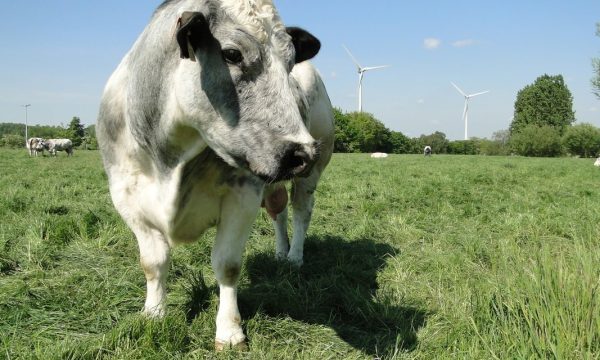Press release Part-time group housing in (rabbit) does is possible, with conditions. "Aggression is a problem, the work is not finished."
Female rabbits - does - should eventually be housed in groups in Flanders just like meat rabbits, so that they can exhibit natural and social behavior. Because aggression towards each other and each other's young is part of that social behavior in the period around bearing young, this is only possible on a part-time basis and under conditions. This appears from doctoral research by Liesbeth Van Damme (ILVO/UGent), commissioned by the Flemish Animal Welfare Department. Placing three feeders together with their young at 22 days (no later) after birth results in the least amount of skin lesions and aggression. Distraction material in the barn can further reduce aggressive behavior. There are also signs that dominant and submissive behavior are stable traits in a proportion of does, which would allow genetic selection toward less aggressive does. More research should shed light on this. "It is important to emphasize that even when following these recommendations there will still be aggression in the groups, the work is not finished," said Liesbeth Van Damme in defending her doctorate.
On 28 September 2023 Liesbeth Van Damme defended her doctoral research ‘Optimizing part-time group housing for female breeding rabbits’. Promotors were Prof. Dr. Frank Tuyttens (Ugent/ILVO) en Dr. Ir. Evelyne Delezie (ILVO).
Part time group housing starting in 2025
Farm animals are increasingly group-housed so that they can experience natural behavior and social interactions with conspecifics. This is already the case for Belgian meat rabbits: they are mandatorily housed in enriched group pens (or parks). But female rabbits, the feeders, are often aggressive during the period around farrowing, making continuous group housing not a safe choice for them and their young. Part-time group housing can be an alternative, if done properly. Because the best approach is still too little known, the sector was given a reprieve for feeders by the Belgian legislature. In the meantime, ILVO was commissioned by the Animal Welfare Division (Department of Environment) to thoroughly investigate part-time housing for feeders in the 3-year project KONSEMI. Liesbeth Van Damme carried out this research, in collaboration with the Flemish rabbit sector. It resulted in concrete recommendations, but also a warning. With about 20 companies, rabbit farming is a small sector in Flanders.
22 days after birth is the best time to start
A trial showed that 22 days after birth was the most optimal time to place single feeders with their young together. The young showed fewer skin lesions due to aggression than with later group housing (25 or 28 days after birth) and the does showed more favorable social contact, such as lying together and grooming.
Smaller groups and/or more space per animal is preferable
Another trial showed that feeders in a group of three had fewer skin lesions than in a group of four. Whether this effect was caused by the smaller group or by the lower stocking density in the group of three is not clear and needs further investigation. In any case, there was no effect on reproductive parameters. A word of caution is in order, however. Even in the groups of three, both feeders and young had frequent skin lesions due to aggression.
Offering pen enrichment can help
We know from research that distraction material or pen enrichment in the barn can reduce aggressive behavior in farm animals. This was demonstrated again in this study, where wooden dividers were placed for additional escape and alfalfa was offered on the floor as a distraction. With success, the test with alfalfa had the lowest number of injured feeders and the test with alfalfa and wooden partitions had the lowest number of dead young. This pen enrichment did not affect the reproductive parameters.
Half of rabbits show consistent behavior
Finally, Liesbeth Van Damme investigated whether the rabbits exhibit consistent social behavior and thus stable traits, which opens up perspectives for genetic selection. The same feeders were therefore followed up for three cycles. Of these, half showed variable behavior, but the other half showed "consistently offensive" or "consistently submissive" behavior. In all groups, moreover, at least one offensive feeder was found to be present. Future research should reveal whether replacing the offensive with a non-offensive feeder in the group effectively reduces aggression, or whether another rabbit takes over the role of offensive feeder.
Warning
In all trials, Van Damme found many injured young and does, even in the trials where less aggressive behavior occurred. When does are placed together, it is inevitable that they establish a social hierarchy. They then exhibit either offensive or submissive, evasive behavior. Nevertheless, it is essential for the rabbits' well-being to avoid prolonged agitation and serious skin damage.
Liesbeth Van Damme: "Simple solutions are not yet available. Mixing different ages or forming stable groups with the same does each time are avenues that still need to be explored. Genetic selection towards more social does also requires further research."
PhD with a golden touch
This doctoral work, at the request of the promoters and with the support of the jury, has been nominated as a candidate for the 'best non-clinical doctorate' of the Faculty of Veterinary Medicine of UGent. This is due to the extensive amount of work done, the number of publications that this PhD has already produced or that are still under review, the thoroughness of the experimental designs, and the steep learning curve of the student.
